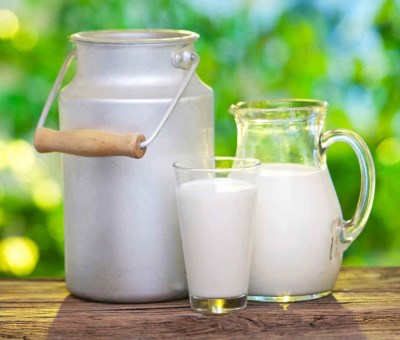Last summer --and before-- I heard speaking out against human consumption of milk, by adults. And, just in summer, I listened, on the radio, to a Spanish scientist (of a Centre for the Study of Food), talking about the problem of milk: that many people were saying that it is not good for adult humans drink milk. But this Spanish scientist explained that the fear drinking milk had been originated after the writing by a Swedish doctor, who was contrary to the consumption of milk, in adulthood. The Spanish scientific --I think wisely and with checked information-- clarified the reason was that the rate of lactose intolerance is very high, in Sweden --not so in other European countries, such as for example in Spain--.
Then,last Friday, I read a news about the human consumption of milk. I have thought that perhaps you are interested, in this theme, and you would like to read a post about it.

4,000 years ago, Europeans acquired the ability to digest milk, beyond infancy; a change, marked by the appearance of a related gene to persistence of the enzyme lactase, on the continent. This is one of the main findings of an investigation, conducted by an international team, involving scientists of the Higher Council for Scientific Research (CSIC), which has determined the most common genes, in Europeans, over the last 8,000 years.
The findings, published in the latest issue of the journal “Nature”, were obtained by analyzing the genomes of 230 individuals of the European prehistory, including 15 from the “Cueva del Mirador”, in Atapuerca (Burgos).
The work, led by scientists at the Broad Institute of Harvard University (USA), the University College of Dublin (Ireland) and the Max Planck Institute (Germany), highlights 12 genetic variants, selected over thousands of years, as a response to various adaptive challenges. The samples include, for the first time, Neolithic genomes from Anatolia (Turkey), dated to over 8,000 years ago.
Currently, the mutation of the gene of the lactase, that ensures its persistence, is present in 100% of Europeans, in Northern Europe. "This is probably the feature that shows greater survival advantage, for the Europeans, ie, the genetic trait, that evolution has selected, with greater intensity. 4,000 years ago, it was a residual mutation, which means that it was later selected, by the European populations, by the great advantage, that supposed to have milk as a food source during adulthood", explains the researcher of the CSIC, Carles Lalueza-Fox, from the Institute of Evolutionary Biology (a joint Centre of the CSIC and the Universitat Pompeu Fabra, in Barcelona).
The ability to digest milk is one of the many adaptations, that arose with the advent of agriculture and livestock, in Europe, 8.500 years ago. New environments, pathogens, allowances and social organizations marked the evolution of these Neolithic populations. Although the exact origin of the mutation of the enzyme lactase is unknown, scientists have found it, for the first time, in people from the central and northern Europe, who lived in the late Neolithic. Specifically, it is in the analyzed samples from Sweden, Hungary and Germany, which have a length of just over 4,000 years.
"The mutation is not required if you process milk, for example, to make cheese; therefore, it does not mean that these people do not took advantage of this resource before. Around the Copper Age, the strong influence, that central Europe receives from the nomads of the steppes, could indicate that they were who introduced the genetic change, on the continent, but no one knows exactly", says Lalueza-Fox.
The scientists have found mutations, involved in the current light-skinned of Europeans, absent traits in populations of hunter-gatherers of the Mesolithic (between 10,000 and 5,000 years ago), like in “the man from La Braña”, a man from León (North west of Spain), who roamed the Peninsula 8,000 years ago and was characterized, by his dark skin and blue eyes. This last feature, was prevalent in the Mesolithic in Europe.
The work indicates other aspects, that depend on hundreds of genes, such as height, which was decreasing, in the Iberian populations, from the Neolithic. This part of the study had a relevant role the analysis of 15 samples, from the Copper Age, dating back between 4,800 and 4,200 years of El Mirador in Atapuerca. These data add to the recent publication of seven genomes of the same age from other site of Atapuerca: El Portalón.
Some of the genes, selected by Europeans, have a biomedical interest and have been related, concretely, to the celiac disease. The scientists have observed mutations, in a gene, to protect against the lack of ergothioneine, an antioxidant, in diets based on farming. Other mutations are associated with ulcerative colitis or irritable bowel syndrome.
For Josep Maria Vergès, a researcher at the Catalan Institute of Human Paleoecology and Social Evolution, "the gotten data are critical for understanding the role played, by cultural adaptations, in the genetic makeup of European populations, in recent prehistory". According Lalueza-Fox, the study "is the first step, to understand how human populations have evolved, in recent times. The oldest sample analysis, in the future, will reveal minor episodes of selection, at regional level ".
Well, I hope that you are agrre with this news. I think that it is surely true that many people have intolerance to the lactose and it is a pity, because milk is a great source of calcium.
Anyway, I think that it is great to have so much information, to any matter, in our lives.
Until my next post, kind regards,
Luis.
Sponsored by Costaluz Lawyers.
Please click below:
